YAMAHA GRIZZLY 125 2013 User Guide
Manufacturer: YAMAHA, Model Year: 2013, Model line: GRIZZLY 125, Model: YAMAHA GRIZZLY 125 2013Pages: 134, PDF Size: 3.93 MB
Page 11 of 134
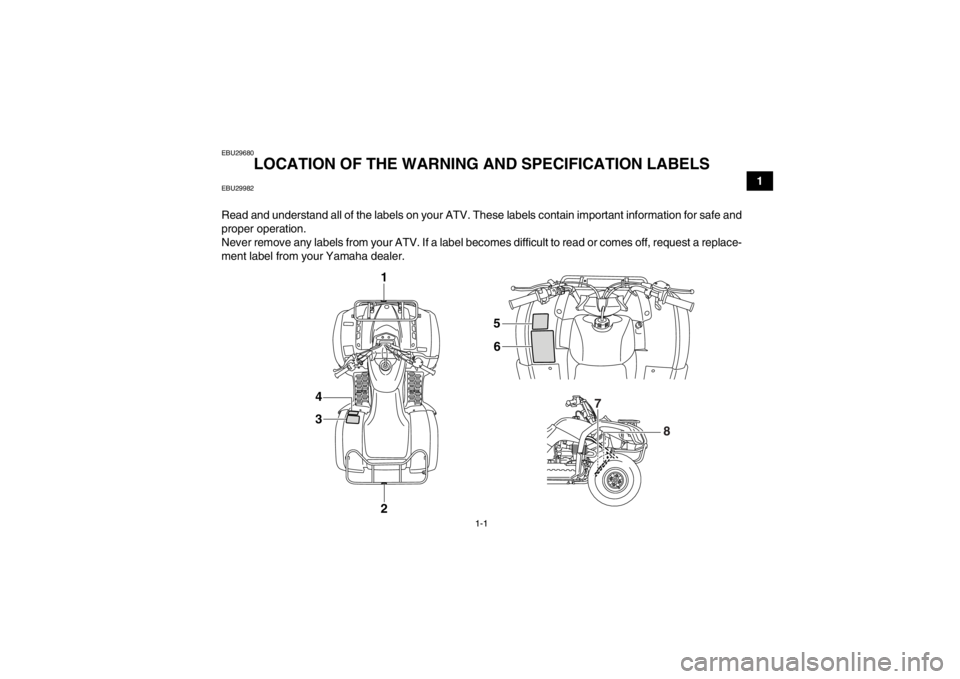
1-1
1
EBU29680
LOCATION OF THE WARNING AND SPECIFICATION LABELS
EBU29982Read and understand all of the labels on your ATV. These labels contain important information for safe and
proper operation.
Never remove any labels from your ATV. If a label becomes difficult to read or comes off, request a replace-
ment label from your Yamaha dealer.
1
3
4
2
7
8
5
6
U1PY61E0.book Page 1 Wednesday, March 14, 2012 5:22 PM
Page 12 of 134
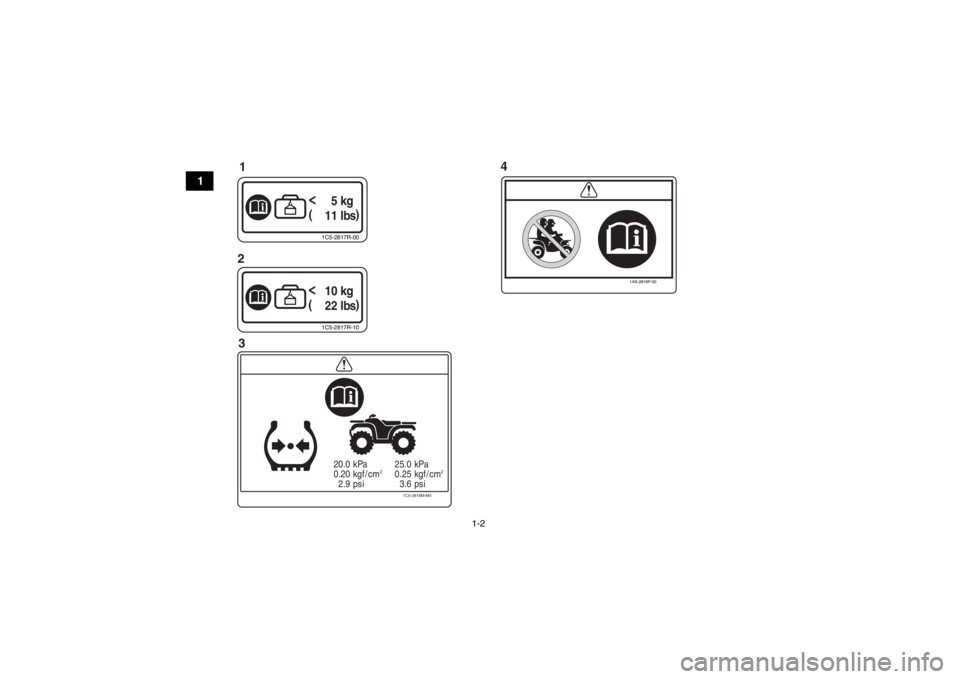
1-2
1
1
2 3 4
1C5-2817R-00
< 5 kg
( 11 Ibs )1C5-2817R-10
< 10 kg
( 22 Ibs )
1C5-2816M-M0
kPa
kgf / cm
2
psi
20.0
0.20
2.9 kPa
kgf / cm
2
psi
25.0
0.25
3.6
1AS-2816P-00
U1PY61E0.book Page 2 Wednesday, March 14, 2012 5:22 PM
Page 13 of 134
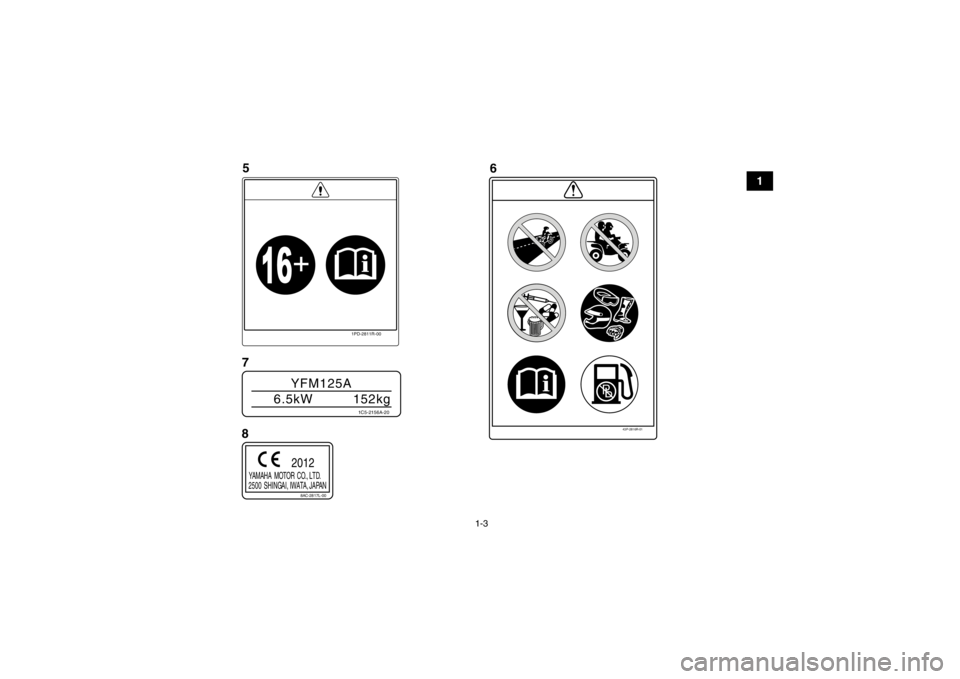
1-3
1
43P-2816R-01
YFM125A
6.5kW 152kg
1C5-2156A-20
8AC-2817L-00
YAMAHA MOTO R C O., LT D.
2500 SHINGAI, IWATA, JAPAN
2012
1PD-2811R-00
5 6
7
8
U1PY61E0.book Page 3 Wednesday, March 14, 2012 5:22 PM
Page 14 of 134
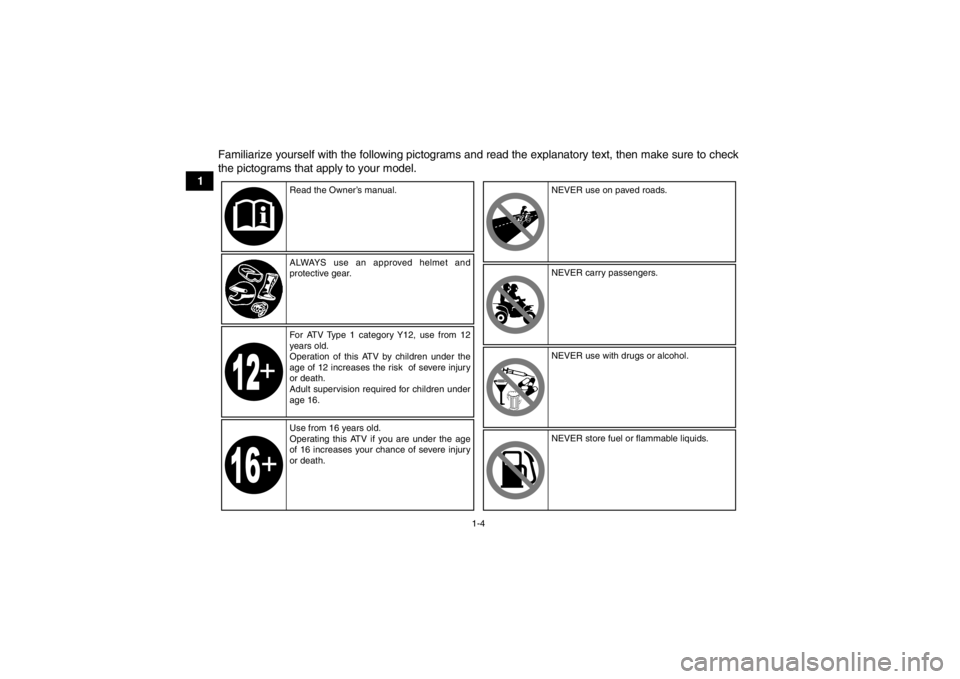
1-4
1Familiarize yourself with the following pictograms and read the explanatory text, then make sure to check
the pictograms that apply to your model.
Read the Owner’s manual.
ALWAYS use an approved helmet and
protective gear.
For ATV Type 1 category Y12, use from 12
years old.
Operation of this ATV by children under the
age of 12 increases the risk of severe injury
or death.
Adult supervision required for children under
age 16.
Use from 16 years old.
Operating this ATV if you are under the age
of 16 increases your chance of severe injury
or death. NEVER use on paved roads.
NEVER carry passengers.
NEVER use with drugs or alcohol.
NEVER store fuel or flammable liquids.
U1PY61E0.book Page 4 Wednesday, March 14, 2012 5:22 PM
Page 15 of 134
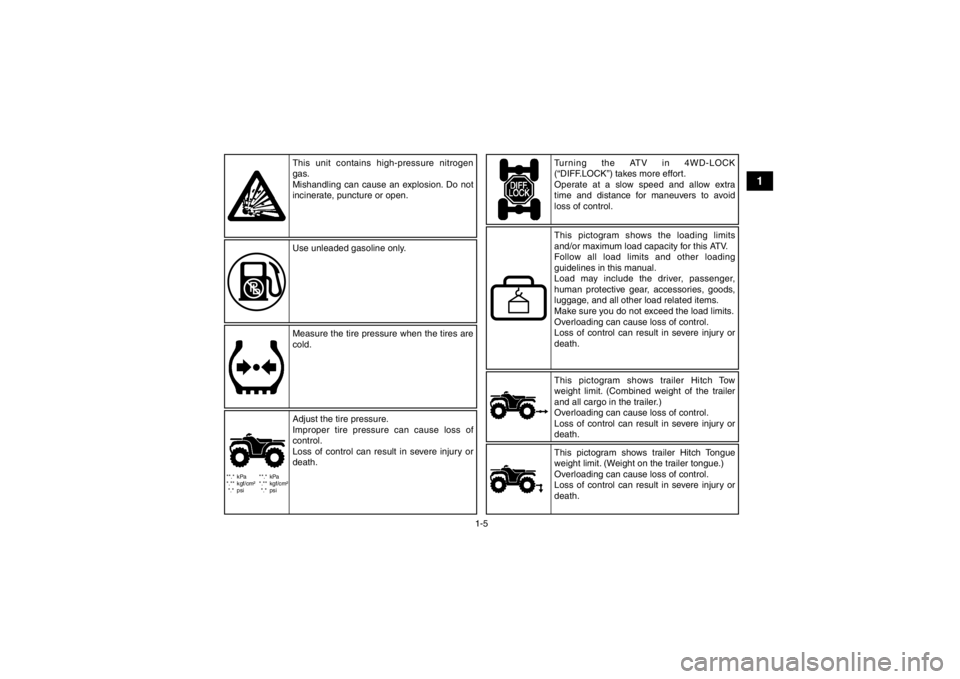
1-5
1
**.* kPa
*.** kgf/cm²*.* psi **.* kPa
*.** kgf/cm²
*.* psi
This pictogram shows trailer Hitch Tow
weight limit. (Combined weight of the trailer
and all cargo in the trailer.)
Overloading can cause loss of control.
Loss of control can result in severe injury or
death.
This unit contains high-pressure nitrogen
gas.
Mishandling can cause an explosion. Do not
incinerate, puncture or open.
Use unleaded gasoline only.
Measure the tire pressure when the tires are
cold. Turning the ATV in 4WD-LOCK
(“DIFF.LOCK”) takes more effort.
Operate at a slow speed and allow extra
time and distance for maneuvers to avoid
loss of control.
Adjust the tire pressure.
Improper tire pressure can cause loss of
control.
Loss of control can result in severe injury or
death. This pictogram shows the loading limits
and/or maximum load capacity for this ATV.
Follow all load limits and other loading
guidelines in this manual.
Load may include the driver, passenger,
human protective gear, accessories, goods,
luggage, and all other load related items.
Make sure you do not exceed the load limits.
Overloading can cause loss of control.
Loss of control can result in severe injury or
death.
This pictogram shows trailer Hitch Tongue
weight limit. (Weight on the trailer tongue.)
Overloading can cause loss of control.
Loss of control can result in severe injury or
death.
U1PY61E0.book Page 5 Wednesday, March 14, 2012 5:22 PM
Page 16 of 134
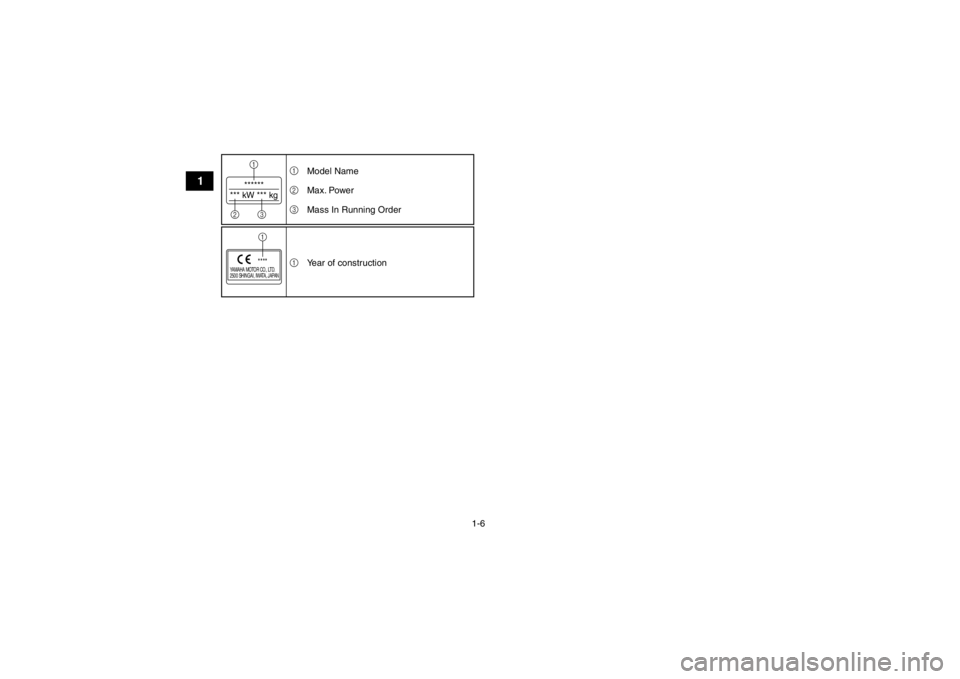
1-6
1
******
*** kW *** kg1
23
YAMAHA MOTOR CO., LTD.
2500 SHINGAI, IWATA, JAPAN
****1 1
2
3
Model Name
Max. Power
Mass In Running Order
1 Year of construction
U1PY61E0.book Page 6 Wednesday, March 14, 2012 5:22 PM
Page 17 of 134
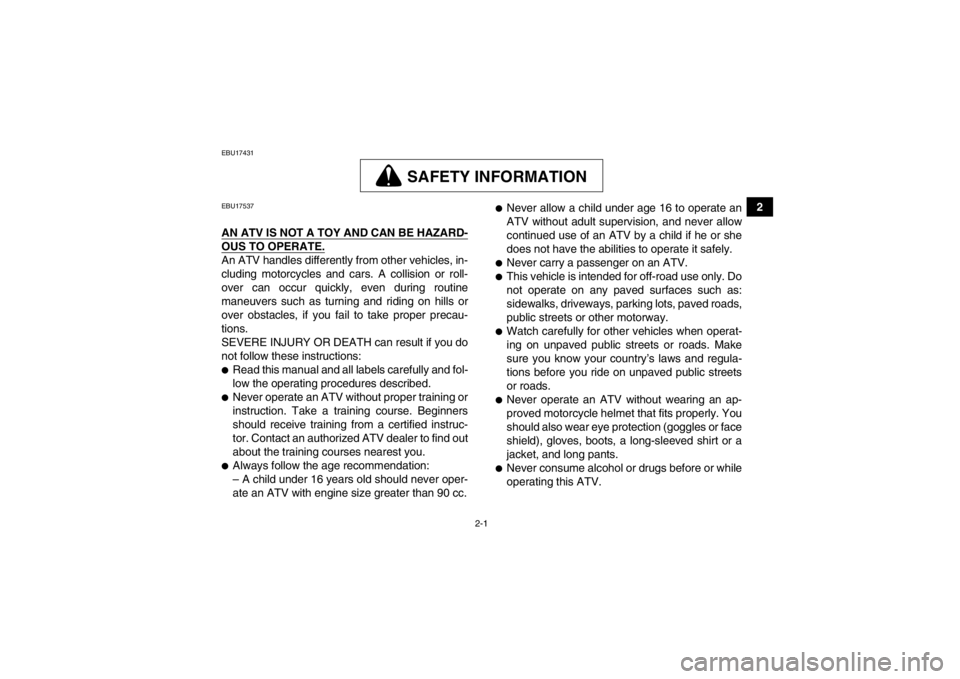
2-1
2
EBU17431
SAFETY INFORMATION
EBU17537AN ATV IS NOT A TOY AND CAN BE HAZARD-OUS TO OPERATE.An ATV handles differently from other vehicles, in-
cluding motorcycles and cars. A collision or roll-
over can occur quickly, even during routine
maneuvers such as turning and riding on hills or
over obstacles, if you fail to take proper precau-
tions.
SEVERE INJURY OR DEATH can result if you do
not follow these instructions:●Read this manual and all labels carefully and fol-
low the operating procedures described.●Never operate an ATV without proper training or
instruction. Take a training course. Beginners
should receive training from a certified instruc-
tor. Contact an authorized ATV dealer to find out
about the training courses nearest you.●Always follow the age recommendation:
– A child under 16 years old should never oper-
ate an ATV with engine size greater than 90 cc.
●Never allow a child under age 16 to operate an
ATV without adult supervision, and never allow
continued use of an ATV by a child if he or she
does not have the abilities to operate it safely.●Never carry a passenger on an ATV.●This vehicle is intended for off-road use only. Do
not operate on any paved surfaces such as:
sidewalks, driveways, parking lots, paved roads,
public streets or other motorway.●Watch carefully for other vehicles when operat-
ing on unpaved public streets or roads. Make
sure you know your country’s laws and regula-
tions before you ride on unpaved public streets
or roads.●Never operate an ATV without wearing an ap-
proved motorcycle helmet that fits properly. You
should also wear eye protection (goggles or face
shield), gloves, boots, a long-sleeved shirt or a
jacket, and long pants.●Never consume alcohol or drugs before or while
operating this ATV.
U1PY61E0.book Page 1 Wednesday, March 14, 2012 5:22 PM
Page 18 of 134

2-2
2
●Never operate at speeds too fast for your skills
or the riding conditions. Always go at a speed
that is proper for the terrain, visibility, operating
conditions, and your experience.●Never attempt wheelies, jumps, or other stunts.●Always inspect your ATV each time you use it to
make sure it is in safe operating condition. Al-
ways follow the inspection and maintenance
procedures and schedules described in this
manual.●Always keep both hands on the handlebars and
both feet on the footboards of the ATV during
operation.●Always go slowly and be extra careful when op-
erating on unfamiliar terrain. Always be alert to
changing terrain conditions when operating the
ATV.●Never operate on excessively rough, slippery or
loose terrain until you have learned and prac-
ticed the skills necessary to control the ATV on
such terrain. Always be especially cautious on
these kinds of terrain.●Always follow proper procedures for turning as
described in this manual. Practice turning at low
speeds before attempting to turn at faster
speeds and never turn at excessive speeds.
●Never operate the ATV on hills too steep for the
ATV or for your abilities. Practice on smaller hills
before attempting larger hills.●Always follow proper procedures for climbing
hills as described in this manual. Check the ter-
rain carefully before you start up any hill. Never
climb hills with excessively slippery or loose sur-
faces. Shift your weight forward. Never open the
throttle suddenly. Never go over the top of a hill
at high speed.●Always follow proper procedures for going down
hills and for braking on hills as described in this
manual. Check the terrain carefully before you
start down any hill. Shift your weight backward.
Never go down a hill at high speed. Avoid going
down a hill at an angle that would cause the ve-
hicle to lean sharply to one side. Go straight
down the hill where possible.●Always follow proper procedures for crossing
the side of a hill as described in this manual.
Avoid hills with excessively slippery or loose sur-
faces. Shift your weight to the uphill side of the
ATV. Never attempt to turn the ATV around on
any hill until you have mastered the turning tech-
nique described in this manual on level ground.
Avoid crossing the side of a steep hill if possible.
U1PY61E0.book Page 2 Wednesday, March 14, 2012 5:22 PM
Page 19 of 134

2-3
2
●Always use proper procedures if you stall or roll
backwards when climbing a hill. To avoid stall-
ing, maintain a steady speed when climbing a
hill. If you stall or roll backwards, follow the spe-
cial procedure for braking described in this man-
ual. Dismount on the uphill side or to a side if
pointed straight uphill. Turn the ATV around and
remount, following the procedure described in
this manual.●Always check for obstacles before operating in a
new area.●Never attempt to operate over large obstacles,
such as large rocks or fallen trees. Always follow
proper procedures when operating over obsta-
cles as described in this manual.●Always be careful when skidding or sliding.
Learn to safely control skidding or sliding by
practicing at low speeds and on level, smooth
terrain. On extremely slippery surfaces, such as
ice, go slowly and be very cautious in order to re-
duce the chance of skidding or sliding out of con-
trol.●Never operate an ATV in fast flowing water or in
water deeper than that recommended in this
manual. Remember that wet brakes may havereduced stopping ability. Test your brakes after
leaving water. If necessary, apply them several
times to let friction dry out the linings.
●Always be sure there are no obstacles or people
behind you when you operate in reverse. When
it is safe to proceed in reverse, go slowly.●Always use the size and type of tires specified in
this manual.●Always maintain proper tire pressure as de-
scribed in this manual.●Never exceed the stated load capacity for an
ATV. Cargo should be properly distributed and
securely attached. Reduce speed and follow in-
structions in this manual for carrying cargo. Al-
low greater distance for braking.●Do not operate your ATV during darkness un-
less it is equipped with a properly functioning
headlight. Off-road riding is inherently danger-
ous and additionally, off-road trails do not have
streetlights to guide you.●Never maintain an ATV without proper knowl-
edge. Contact an authorized ATV dealer to in-
form you on basic ATV maintenance. Certain
maintenance can only be carried out by certified
staff.
U1PY61E0.book Page 3 Wednesday, March 14, 2012 5:22 PM
Page 20 of 134

2-4
2In the event of an accident
1. If serious injuries are incurred, you may be safer staying next to your vehicle; it may
shield you from oncoming riders. Depending
on your injuries and position in the trail; you
must make a judgment call as to whether you
should move to a position off the trail. If you
have sustained head, neck, or back injuries,
or cannot feel your limbs, you should not
move. Keep your helmet on and remain mo-
tionless. Lie down next to your vehicle and
wait for help.
2. If less serious injuries are incurred and you can walk, then move to a position off the trail.
Check yourself for injuries and apply first aid
as needed.
3. If your injuries are light, when safe to do so, move your vehicle off the trail to avoid colli-
sions with oncoming riders. Check for injuries
and apply first aid as necessary. If you can
physically operate your vehicle, inspect your
vehicle. If the vehicle is in safe operating con-
dition and you can safely operate it, restart it
and ride gently back to camp or other known
location where you can receive medical atten- tion. If necessary, contact your riding party or
local authorities to let them know where you
are and what has happened.
In the event of a breakdown 1. If your vehicle will not restart or is not in safe operating condition, turn off the main switch
and engine stop switch. If the breakdown oc-
curs at twilight or night, leave the main switch
on so that your lights may warn other riders of
your stopped vehicle.
2. Get out of danger. Check for oncoming vehi- cles and when safe, push your vehicle to the
side of the trail or even off the main trail to
avoid any possible collisions with oncoming
riders. If you cannot move your vehicle by
yourself, when safe, walk to the nearest van-
tage point and signal an oncoming rider to
help you push your vehicle to a safe place off
the trail.
3. Inspect your vehicle for any immediate haz- ardous conditions. The most obvious hazard-
ous conditions are leaking fuel and
ungrounded or broken wiring. Visually check
for broken wiring and leaking fuel. Leaking
fuel can be confirmed by the odor of gasoline.
U1PY61E0.book Page 4 Wednesday, March 14, 2012 5:22 PM